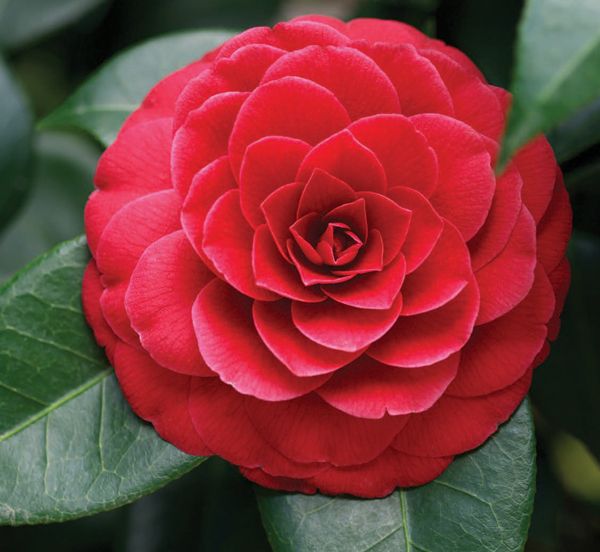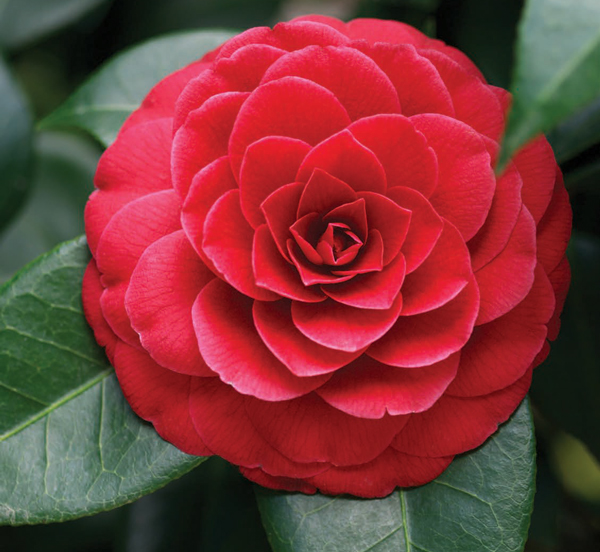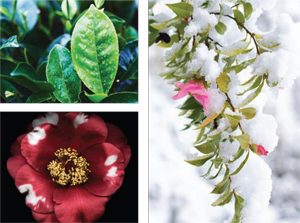Camellia Reigns | Queen of the Winter Flowers


With their striking evergreen foliage and showy blooms, camellias reign supreme, just as they did in ancient China when emperors and temple priests revered them. If you’ve ever enjoyed a cup of tea, you have sampled the leaf of the camellia. All tea—black, oolong, green, or white—comes from the Camellia sinensis plant in the same way that all wine comes from the grape.
 Tea was first sourced in China from the camellia. Popular legend says tea was discovered by Emperor Shennong in ancient China. As the story goes, he stopped to rest beneath a tree and began boiling water for a pot of soup, but before he could add ingredients, dried camellia leaves floated down, infusing the water for the first pot of tea.
Tea was first sourced in China from the camellia. Popular legend says tea was discovered by Emperor Shennong in ancient China. As the story goes, he stopped to rest beneath a tree and began boiling water for a pot of soup, but before he could add ingredients, dried camellia leaves floated down, infusing the water for the first pot of tea.
Camellias were cultivated in the gardens of China and Japan centuries before they were discovered in Europe (samovartea.com/ how-tea-is-made). To the ancient Chinese, camellias produced the ideal blossoms: smooth, flat petals in a rounded form with perfect symmetry. In ancient Japan, the plant held a special place in Japanese thought and was imbued with religious symbolism. Camellia plantings were an essential feature of temple gardens and graveyards. Today many of the oldest camellia varieties are found in temple compounds.
With the expansion of the tea trade in the 18th century, new varieties began to emerge in England, imported through the British East India Company. Camellia japonica was the first camellia plant to be grown in England around 1740 and was imported to America in 1797. It was a plant for the wealthy, often grown in glass greenhouses in the north because the winters were too harsh for the plant to survive. Camellias soon made their way down south where conditions were more suitable for their cultivation. Some of the oldest camellias today can be found in southern plantation gardens.
By the 1840s the camellia was at the height of fashion as a luxury flower. After World War I, plants were highly sought-after as woodland shrubs in milder climates. Camellia shows began springing up in the 1930s and the American Camellia Society was founded in 1945. Today the society has 53 clubs and boasts approximately 5,000 members. There are over 200 species of camellias, with varieties numbering to 20,000, though many of these are not found in the western world.
 Camellias are grown as ornamental plants for their blossoms, highly valued for their early flowering—usually in late winter. Most camellias on the market in the United States are one of three species—japonica, sasanqua, or reticulata—or hybrids thereof. Camellia japonica is a large shrub or small tree with an upright habit of eight to 10 feet and glossy green leaves. Camellia sasanqua, a profuse fall bloomer, is bushier than japonica; its leaves are smaller making it an excellent choice for hedges and ground cover. Camellia reticulata has a more open and upright branching habit than the others, with leaves that are matte rather than glossy and large flowers of six inches or more.
Camellias are grown as ornamental plants for their blossoms, highly valued for their early flowering—usually in late winter. Most camellias on the market in the United States are one of three species—japonica, sasanqua, or reticulata—or hybrids thereof. Camellia japonica is a large shrub or small tree with an upright habit of eight to 10 feet and glossy green leaves. Camellia sasanqua, a profuse fall bloomer, is bushier than japonica; its leaves are smaller making it an excellent choice for hedges and ground cover. Camellia reticulata has a more open and upright branching habit than the others, with leaves that are matte rather than glossy and large flowers of six inches or more.
All camellias thrive in acidic soil and light shade; in Virginia’s hardiness zone seven camellias flourish outdoors. A soil pH (degree of acidity or alkalinity) of 6.0 to 6.5 is considered best for camellias; ground should be tested before planting to see if the soil needs amending. According to Heart of Virginia Master Gardeners, Camellias should be grown in a rich soil, high in organic matter and fertilized once a year in early spring.
Proper shade and wind protection will enhance the growth of camellias. They need protection from winter sun and wind, so northern exposure is generally the best choice for planting. In humid climates, white and pale pink blossoms may burn if exposed to bright sun. Sasanqua cultivars can tolerate more sun than the others and is the better choice for a spot with no shade.
Maintenance of established camellia bushes and shrubs is minimal—pruning is only needed if a branch is damaged. They don’t attract pests and deer tend to leave them alone. The only important grooming task for camellias is deadheading—removing spent flower heads.
Here in Virginia with our bleak winters and bare gardens, a shrub boasting pink or red blossoms is a most welcome and delightful sight. Late fall is the time, during our area’s mild weather, to plant camellias for a winter show. Since sasanqua is fall blooming and reticulata is hardy to only 25 degrees, choose japonica, available at most central Virginia nurseries and garden stores.
In the language of flowers, the ancient tradition of associating blooms with sentiments or virtues, Camellia japonica embodies perfect and supreme loveliness, a surefire remedy for the winter blues. ✦
acidic soil, black, Camellia japonica, Camellia reticulata, Camellia sasanqua, Camellia sinensis, camellias, evergreen foliage, fall blooming, garden, green, oolong, ornamental plants, showy blooms, tea, white, woodland shrubs






